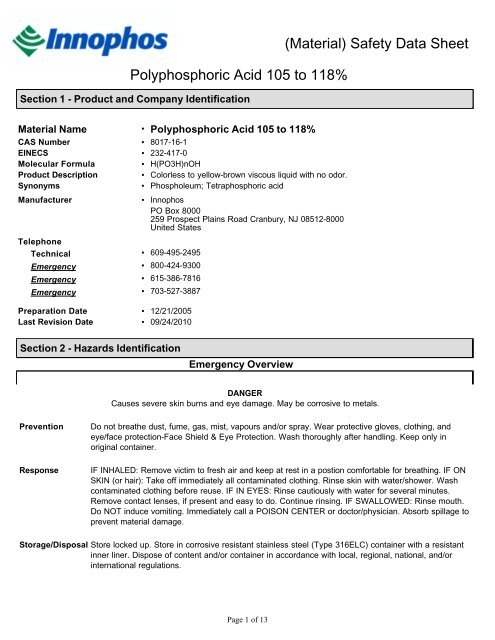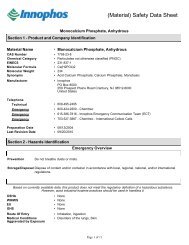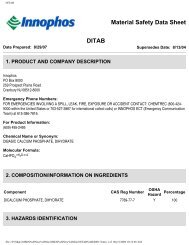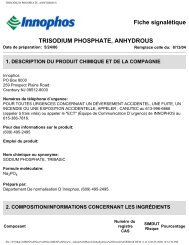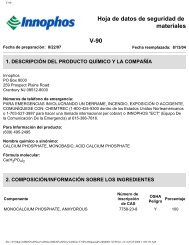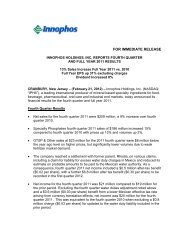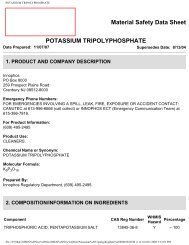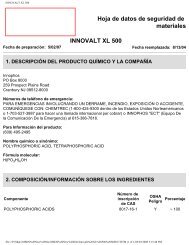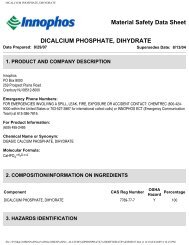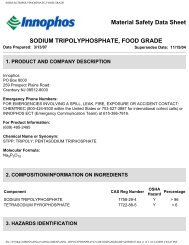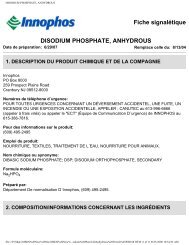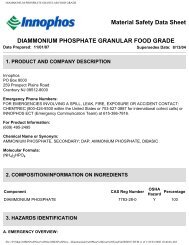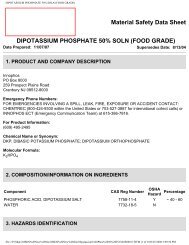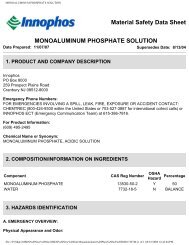Polyphosphoric Acid 105 to 118% - Innophos
Polyphosphoric Acid 105 to 118% - Innophos
Polyphosphoric Acid 105 to 118% - Innophos
You also want an ePaper? Increase the reach of your titles
YUMPU automatically turns print PDFs into web optimized ePapers that Google loves.
<strong>Polyphosphoric</strong> <strong>Acid</strong> <strong>105</strong> <strong>to</strong> <strong>118%</strong>Section 1 - Product and Company Identification(Material) Safety Data SheetMaterial Name ▪ <strong>Polyphosphoric</strong> <strong>Acid</strong> <strong>105</strong> <strong>to</strong> <strong>118%</strong>CAS Number ▪ 8017-16-1EINECS ▪ 232-417-0Molecular Formula▪ H(PO3H)nOHProduct Description▪ Colorless <strong>to</strong> yellow-brown viscous liquid with no odor.Synonyms▪ Phospholeum; Tetraphosphoric acidManufacturerTelephoneTechnical ▪ 609-495-2495Emergency ▪ 800-424-9300Emergency ▪ 615-386-7816Emergency ▪ 703-527-3887Preparation Date ▪ 12/21/2005Last Revision Date ▪ 09/24/2010▪ <strong>Innophos</strong>PO Box 8000259 Prospect Plains Road Cranbury, NJ 08512-8000United StatesSection 2 - Hazards IdentificationEmergency OverviewDANGERCauses severe skin burns and eye damage. May be corrosive <strong>to</strong> metals.PreventionResponseDo not breathe dust, fume, gas, mist, vapours and/or spray. Wear protective gloves, clothing, andeye/face protection-Face Shield & Eye Protection. Wash thoroughly after handling. Keep only inoriginal container.IF INHALED: Remove victim <strong>to</strong> fresh air and keep at rest in a postion comfortable for breathing. IF ONSKIN (or hair): Take off immediately all contaminated clothing. Rinse skin with water/shower. Washcontaminated clothing before reuse. IF IN EYES: Rinse cautiously with water for several minutes.Remove contact lenses, if present and easy <strong>to</strong> do. Continue rinsing. IF SWALLOWED: Rinse mouth.Do NOT induce vomiting. Immediately call a POISON CENTER or doc<strong>to</strong>r/physician. Absorb spillage <strong>to</strong>prevent material damage.S<strong>to</strong>rage/Disposal S<strong>to</strong>re locked up. S<strong>to</strong>re in corrosive resistant stainless steel (Type 316ELC) container with a resistantinner liner. Dispose of content and/or container in accordance with local, regional, national, and/orinternational regulations.Page 1 of 13
OSHAWHMIS▪ Corrosive▪ Class E - Corrosive materialsEU▪ Corrosive - CR35GHSRoute Of EntryMedical ConditionsAggravated by Exposure▪ Corrosive <strong>to</strong> Metals - Category 1, Skin Corrosion/Irritation - Category 1A, Serious EyeDamage, Eye Irritation - Category 1▪ Inhalation, Skin, Eye, Ingestion▪ Skin, LungsNFPA:Potential Health EffectsInhalationAcute (Immediate)Chronic (Delayed)SkinAcute (Immediate)Chronic (Delayed)EyeAcute (Immediate)Chronic (Delayed)IngestionAcute (Immediate)Chronic (Delayed)Carcinogenic Effects▪ May cause corrosive burns - irreversible damage.▪ Repeated or prolonged exposure <strong>to</strong> corrosive fumes may cause bronchial irritation withchronic cough.▪ Causes severe skin burns and eye damage.▪ Repeated or prolonged exposure <strong>to</strong> corrosive materials will cause dermatitis.▪ Corrosive. Can cause permanent damage <strong>to</strong> the cornea, blindness.▪ Repeated or prolonged exposure <strong>to</strong> corrosive materials or fumes may causeconjunctivitis.▪ Causes corrosion, burns <strong>to</strong> mouth and esophagus, abdominal pain, chest pain,nausea, vomiting, diarrhea, seizures. Aspiration of the swallowed or vomited productcan cause severe pulmonary complications.▪ Repeated or prolonged exposure <strong>to</strong> corrosive materials or fumes may causegastrointestinal distrubances.▪ This product does not contain any ingredient designated by IARC, NTP, ACGIH orOSHA as probable or suspected human carcinogens.Page 2 of 13
Section 3 - Composition/Information on IngredientsHazardous ComponentsChemical Name CAS %(weight) UN;EINECS LD50/LC50EU Classification& R Phrases<strong>Polyphosphoric</strong> acid 8017-16-1 100% 232-417-0 NDA NDA NDAAccording <strong>to</strong> the Globally Harmonized Standard for Classification and Labeling (GHS) this product is consideredhazardous. Under United States Regulations (29 CFR 1900.1200 - Hazard Communication Standard), this product isconsidered hazardous. In Canada, the product mentioned above is considered hazardous under the Workplace HazardousMaterials Information System (WHMIS). This product is considered dangerous according <strong>to</strong> the European Directive67/548/EEC.OtherSection 4 - First Aid MeasuresInhalationSkinEyeIngestionNotes <strong>to</strong> PhysicianOther Information▪ Administer oxygen if breathing is difficult. Do not use mouth-<strong>to</strong>-mouth method if victiminhaled the substance; give artificial respiration with the aid of a pocket maskequipped with a one-way valve or other proper respira<strong>to</strong>ry medical device. Give artificialrespiration if victim is not breathing. Move victim <strong>to</strong> fresh air.▪ For minor skin contact, avoid spreading material on unaffected skin. In case of contactwith substance, immediately flush skin with running water for at least 20 minutes.Wash skin with soap and water. Remove and isolate contaminated clothing andshoes. Wash contaminated clothing before reuse.▪ In case of contact with substance, immediately flush eyes with running water for atleast 20 minutes. Seek immediate medical attention, preferably with anophthalmologist. If the physician is not immediately available, eye irrigation should becontinued for an additional 20 minutes. If it is necessary <strong>to</strong> transport the patient <strong>to</strong> aphysician and the eye needs <strong>to</strong> be bandaged, use a dry sterile cloth pad and coverboth eyes.▪ If swallowed give 2-3 glasses of water if victim is conscious and alert. Do not giveanything by mouth <strong>to</strong> an unconscious person. Do NOT induce vomiting. Obtainmedical attention immediately if ingested. Do not use mouth-<strong>to</strong>-mouth method if victimingested the substance. Do not leave victim unattended. To prevent aspiration ofswallowed product, lay victim on side with head lower than waist. Persons attendingthe victim should avoid direct contact with heavily contaminated clothing and vomitus.Wear impervious gloves while decontaminating skin and hair.▪ All treatments should be based on observed signs and symp<strong>to</strong>ms of distress in thepatient. Consideration should be given <strong>to</strong> the possibility that overexposure <strong>to</strong> materialsother than this product may have occurred.▪ Call 911 or emergency medical service. Ensure that medical personnel are aware ofthe material(s) involved and take precautions <strong>to</strong> protect themselves. Keep victim warmand quiet.Section 5 - Fire Fighting MeasuresExtinguishing MediaUnsuitable ExtinguishingMediaFirefighting ProceduresUnusual Fire and ExplosionHazardsHazardous CombustionProducts▪ Not combustible. Use extinguishing media suitable for surrounding fire.▪ None known.▪ Keep unauthorized personnel away.Dike area <strong>to</strong> prevent runoff and contamination of water sources. Dispose of fire controlwater later. Evacuate residents who are downwind of fire. Persons who may have beenexposed <strong>to</strong> contaminated smoke should be immediately examined by a physician andchecked for symp<strong>to</strong>ms of poisoning. The symp<strong>to</strong>ms should not be mistaken for heatexhaustion or smoke inhalation.▪ Not combustible. Under fire conditions, <strong>to</strong>xic, corrosive fumes are emitted.▪ Non-combustible, substance itself does not burn but may decompose upon heating <strong>to</strong>produce corrosive fumes.Page 3 of 13
Protection of Firefighters▪ Structural firefighters' protective clothing provides limited protection in fire situationsONLY; it is not effective in spill situations where direct contact with the substance ispossible.Wear chemical protective clothing that is specifically recommended by themanufacturer. It may provide little or no thermal protection.Wear positive pressure self-contained breathing apparatus (SCBA).Section 6 - Accidental Release MeasuresPersonal PrecautionsEmergency ProceduresEnvironmental PrecautionsContainment/Clean-upMeasuresProhibited Materials▪ Ventilate enclosed areas. Do not <strong>to</strong>uch damaged containers or spilled material unlesswearing appropriate protective clothing.▪ Keep unauthorized personnel away. Dike spill using absorbent or impervious materialssuch as earth, sand or clay. Dike or retain dilution water or water from firefighting forlater disposal.▪ Prevent entry in<strong>to</strong> waterways, sewers, basements or confined areas.▪ Exercise caution during neutralization as considerable heat may be generated.Neutralize spill area with soda ash, sodium bicarbonate or lime. Flush neutralized spillwith copious amounts of water.▪ None known.Section 7 - Handling and S<strong>to</strong>rageHandling▪ Do not get on skin or in eyes. Avoid breathing vapors and mists. Do not ingest. Handleand open container with care. Use only with adequate ventilation. Use caution whencombining with water; DO NOT add water <strong>to</strong> corrosive liquid, ALWAYS add corrosiveliquid <strong>to</strong> water while stirring <strong>to</strong> prevent release of heat, steam and fumes.S<strong>to</strong>rage▪ Keep away from incompatible materials. S<strong>to</strong>re locked up. Keep container/packagetightly closed in a cool, well-ventilated place. Ventilate enclosed areas. S<strong>to</strong>rage tanks,pipes and pumps should be equipped with external heating and insulation <strong>to</strong> maintainat or above minimum s<strong>to</strong>rage temperature. This material is corrosive <strong>to</strong> commonmetals such as mild steel, copper, brass and bronze and may generate flammablehydrogen gas as a result of this reaction.Special Packaging Materials ▪ Recommended container material: stainless steel (Type 316ELC).Incompatible Materials orIgnition Sources▪ This material is corrosive <strong>to</strong> common metals such as mild steel, copper, brass andbronze. Reacts with water <strong>to</strong> generate heat and forms phosphoric acid. The reaction isnot violent.Section 8 - Exposure Controls/Personal ProtectionPersonal Protective EquipmentPic<strong>to</strong>gramsRespira<strong>to</strong>ryEye/FaceHandsSkin/BodyGeneral Industrial HygieneConsiderationsEngineeringMeasures/Controls▪▪ Follow the OSHA respira<strong>to</strong>r regulations found in 29 CFR 1910.134 or EuropeanStandard EN 149. Use a NIOSH/MSHA or European Standard EN 149 approvedrespira<strong>to</strong>r if exposure limits are exceeded or symp<strong>to</strong>ms are experienced.▪ Wear face shield and eye protection. Wear splash goggles. An emergency eye washmust be readily accessible <strong>to</strong> the work area.▪ Wear protective gloves selected with regard <strong>to</strong> both durability as well as permeationresistance.▪ Wear protective clothing -Full Body Suit▪ Do not get in eyes or on skin or clothing. Wash thoroughly with soap and water afterhandling and before eating, drinking, or using <strong>to</strong>bacco. Handle in accordance withgood industrial hygiene and safety practice.▪ Good general ventilation should be used. Ventilation rates should be matched <strong>to</strong>conditions. If applicable, use process enclosures, local exhaust ventilation, or otherengineering controls <strong>to</strong> maintain airborne levels below recommended exposure limits.Page 4 of 13
<strong>Polyphosphoric</strong> acidas Phosphoric <strong>Acid</strong>(7664-38-2)<strong>Polyphosphoric</strong>acidas Phosphoric <strong>Acid</strong>(7664-38-2)<strong>Polyphosphoric</strong> acidas Phosphoric <strong>Acid</strong>(7664-38-2)<strong>Polyphosphoric</strong> acidas Phosphoric <strong>Acid</strong>(7664-38-2)<strong>Polyphosphoric</strong>acidas Phosphoric <strong>Acid</strong>(7664-38-2)If exposure limits have not been established, maintain airborne levels <strong>to</strong> an acceptablelevel.Exposure Limits/GuidelinesResult ACGIH Argentina Australia Canada Ontario Canada QuebecSTELs 3 mg/m3 STEL 3 mg/m3 STEL 3 mg/m3 STEL 3 mg/m3 STEV 3 mg/m3 STEVTWAs 1 mg/m3 TWA 1 mg/m3 TWA 1 mg/m3 TWA 1 mg/m3 TWAEV 1 mg/m3 TWAEVExposure Limits/Guidelines (Con't.)Result China Egypt Germany DFG Germany TRGS IndiaSTELs 3 mg/m3 STEL 3 mg/m3 STEL Not established Not established 3 mg/m3 STELTWAs 1 mg/m3 TWA Not established Not establishedCeilings Not establishedNot establishedMAKs Not established Not established4 mg/m3 Peak(inhalable fraction)2 mg/m3 MAK(inhalable fraction)2 mg/m3 TWA(inhalable fraction,exposure fac<strong>to</strong>r 2)Not establishedNot established1 mg/m3 TWANot establishedNot establishedExposure Limits/Guidelines (Con't.)Result Indonesia Japan Korea Malaysia MexicoTWAs 1 mg/m3 NAB 1 mg/m3 OEL 1 mg/m3 TWA 1 mg/m3 TWA 1 mg/m3 TWASTELs Not established Not established 3 mg/m3 STEL Not established 3 mg/m3 STELExposure Limits/Guidelines (Con't.)Result New Zealand NIOSH OSHA OSHA Vacated SingaporeSTELs Not established 3 mg/m3 STEL Not established 3 mg/m3 STEL 3 mg/m3 STELTWAs 1 mg/m3 TWA 1 mg/m3 TWA 1 mg/m3 TWA 1 mg/m3 TWA 1 mg/m3 PELExposure Limits/Guidelines (Con't.)Result South Africa SwitzerlandMAKs Not established 1 mg/m3 MAKSTELs 3 mg/m3 STEL 2 mg/m3 STELTWAs 1 mg/m3 TWA Not establishedKey <strong>to</strong> abbreviationsMaximale Arbeitsplatz Konzentration is the maximum permissibleOEL = Occupational Exposure Limit(s) MAK =concentrationShort Term Exposure Limits are based on 15-STEL =minute exposuresSTEV = Short Term Exposure Value NAB = Threshold Values (Indonesia)TWATime-Weighted Averages are based on 8h/day,=40h/week exposuresTWAEV = Time-Weighted Average Exposure ValuePELPermissible Exposure Level determined by the Occupational Safety and=Health Administration (OSHA)ACGIH = American Conference of Governmental Industrial HygieneOSHA = Occupational Safety and Health AdministrationSection 9 - Physical and Chemical PropertiesPhysical Form▪ LiquidAppearance/Description ▪ Colorless <strong>to</strong> yellow-brown viscous liquid with no odor.Color : Colorless <strong>to</strong> yellow-brown.Odor : OdorlessTaste : NDAOdor Threshold : NDABoiling Point: 572 <strong>to</strong> 1022 F(300 <strong>to</strong> 550 C) Vapor Pressure: NDAMelting Point: 61 F(16.1111 C) Vapor Density: NDAPage 5 of 13
Specific Gravity: 2.05 Evaporation Rate: NDADensity: 17.1073 lbs/gal VOC (Wt.): NDABulk Density: NDA VOC (Vol.): NDAWater Solubility: Soluble Volatiles (Wt.): NDASolvent Solubility: NDA Volatiles (Vol.): NDAViscosity: NDA Flash Point: NDAHalf-Life: NDA Flash Point Test Type: NDAOctanol/Water Partitioncoefficient:NDA UEL: NDACoefficient of Water: NDA LEL: NDABioaccumulation Fac<strong>to</strong>r: NDA Au<strong>to</strong>ignition: NDApH: < 1Section 10 - Stability and ReactivityStabilityHazardous PolymerizationConditions <strong>to</strong> AvoidIncompatible MaterialsHazardous DecompositionProducts▪ Stable▪ Hazardous polymerization will not occur.▪ Incompatible materials. Moisture. Excess heat.▪ Water, strong bases, metals. Reacts with metals <strong>to</strong> liberate flammable hydrogen gas.Reacts with water <strong>to</strong> generate heat and forms phosphoric acid. The reaction is notviolent.▪ Oxides of phosphorus.Section 11 - Toxicological InformationOther Material Information<strong>Polyphosphoric</strong> <strong>Acid</strong> <strong>105</strong>-<strong>118%</strong>▪ This material is an acid. The primary effects and <strong>to</strong>xicity of this material are due <strong>to</strong> itscorrosive nature.Test Type Dosage Units Route Species Duration Results Test ClassAcute Toxicity 2740 mg/kg Ingestion/Oral Rabbit NDA LD50 NDA NDAAcute Toxicity > 850 mg/m³ Inhalation Rat1 Hour(s)ContinuousIrritation NDA NDA Eye Rabbit NDA NDALC50 NDA NDASevere irritation,irreversible, burns(corrosive)Acute Toxicity 1530 mg/kg Ingestion/Oral Rat NDA LD50 NDA NDAIrritation NDA NDA Skin Rabbit NDA NDAKey <strong>to</strong> abbreviationsTC = Toxic ConcentrationLD = Lethal DoseSevere irritation,irreversible, burns(corrosive)TargetOrgansNDANDACommentsData forphosphoricacidData forPhosphoricacidData forphosphoricacidData forphosphoricacidData forphosphoricacidPage 6 of 13
Section 12 - Ecological InformationEcological FatePersistence/DegradabilityBioaccumulation PotentialMobility in Soil▪ No data found for product.▪ No data found for product.▪ No data found for product.▪ No data found for product.Section 13 - Disposal ConsiderationsProductPackaging▪ Dispose of content and/or container in accordance with local, regional, national, and/orinternational regulations. This material is considered an EPA hazardous waste. EPA"RCRA" Hazardous Waste Code: "C" Corrosive.▪ No data available.Section 14 - Transportation InformationDOT - United States - Department of TransportationShipping Name: Phosphoric acid solutionID Number: UN1805Hazard Class: 8Packing Group: IIIPassenger aircraft/rail: 5.00 LCargo aircraft/rail: 60.00 LTDG - Canada - Transport of Dangerous GoodsShipping Name: PHOSPHORIC ACID, LIQUIDID Number: UN1805Hazard Class: 8Labeling Class: 8Packing Group: IIIExplosive Limit and Limited Quantity Index: 5.00Passenger Carrying Road Vehicle or Passenger Carrying RailwayVehicle Index: 5.00IMO/IMDG –International Maritime TransportShipping Name: Phosphoric acid solutionID Number: UN1805Hazard Class: 8Labeling Class: 8ADN - Europe Transport of Dangerous Goods by Road/Inland WaterwayShipping Name: Phosphoric acid solutionID Number: UN1805Hazard Class: 8Labeling Class: 8ADR - Europe Transport of Dangerous Goods by Road/Inland WaterwayShipping Name: Phosphoric acid solutionID Number: UN1805Hazard Class: 8Labeling Class: 8Page 7 of 13
Section 15 - Regula<strong>to</strong>ry InformationSARA Hazard Classifications ▪ AcuteRisk & Safety Phrases ▪ R35 Causes severe burns.R41 Risk of serious damage <strong>to</strong> eyes.S1 Keep locked up.S26 In case of contact with eyes, rinse immediately with plenty of water and seekmedical advice.S36/37/39 Wear suitable protective clothing, gloves and eye/face protection.Inven<strong>to</strong>ryComponent CAS China New Zealand Canada DSL EU EINECS TSCA<strong>Polyphosphoric</strong>acid8017-16-1 Yes Yes Yes Yes YesInven<strong>to</strong>ry (Con't.)Component CAS Australia AICS Korea KECL Philippines PICCS<strong>Polyphosphoric</strong> acid 8017-16-1 Yes Yes YesAustraliaLaborAustralia - Hazardous Substances - Substances Requiring Health SurveillanceNone ListedAustralia - High Volume Industrial Chemicals ListNone ListedAustralia - List of Designated Hazardous Substances - ClassificationNone ListedAustralia - Major Hazard Facilities - Threshold Quantity (Table 1)None ListedAustralia - Major Hazard Facilities - Threshold Quantity for Materials (Table 2)None ListedAustralia - South Australia - Hazardous Substances Prohibited for Specified UsesNone ListedAustralia - South Australia - Hazardous Substances Requiring Health SurveillanceNone ListedAustralia - Tasmania - Workplace Health and Safety - Hazardous Substances Prohibited for Specific UsesNone ListedAustralia - Tasmania - Workplace Health and Safety - Hazardous Substances Requiring Health SurveillanceNone ListedAustralia - Western Australia - Hazardous Substances Prohibited for Specified UsesNone ListedAustralia - Western Australia - Hazardous Substances Requiring Health SurveillanceNone ListedEnvironmentAustralia - National Pollutant Inven<strong>to</strong>ry (NPI) Substance ListNone ListedAustralia - Ozone Protection Act - Scheduled SubstancesNone ListedAustralia - Priority Existing Chemical ProgramNone ListedOtherThe Australia Group - Export Control List - Chemical Weapons PrecursorsNone ListedCanadaPage 8 of 13
LaborCanada - List of Prohibited and Restricted Cosmetic Ingredients (The Cosmetic Ingredient Hotlist)None ListedCanada - WHMIS - Classifications of SubstancesNone ListedCanada - WHMIS - Ingredient Disclosure ListNone ListedEnvironmentCanada - CEPA - Priority Substances ListNone ListedCanada - Ozone Depleting Substances - Schedule 3None ListedChinaEnvironmentChina - Ozone Depleting Substances - First ScheduleNone ListedChina - Ozone Depleting Substances - Second ScheduleNone ListedChina - Ozone Depleting Substances - Third ScheduleNone ListedOtherChina - Annex I & II - Controlled Chemicals ListsNone ListedChina - Classification and Labeling of Dangerous Chemical Substances Commonly Used● <strong>Polyphosphoric</strong> acid 8017-16-1 100% Primary Symbol: 16 Primary Class: corrosive Statements: 5.46, 5.99, 5.112 (with 84% P2O5)China - Dangerous Goods ListNone ListedCroatiaEnvironmentCroatia - Air Quality - Emission Limits for Stationary SourcesNone ListedCroatia - Air Quality - Limit Values for Gaseous PollutantsNone ListedCroatia - Air Quality - Recommended Values for Gaseous PollutantsNone ListedCroatia - Ozone Depleting Substances - Annex A, Group INone ListedEgyptEnvironmentEgypt - Air Pollutants - Emissions Limits - Overall ParticlesNone ListedEgypt - Air Pollutants - Maximum LimitsNone ListedEuropeEnvironmentEU - Substances Depleting the Ozone layer (1005/2009) - Annex I SubstancesNone ListedOtherEU - CLP (1272/2008) - Annex VI - Table 3.2 - ClassificationNone ListedPage 9 of 13
IndiaEU - CLP (1272/2008) - Annex VI - Table 3.2 - Concentration LimitsNone ListedEU - CLP (1272/2008) - Annex VI - Table 3.2 - LabellingNone ListedEnvironmentIndia - Hazardous Chemical Rules - List of Hazardous and Toxic ChemicalsNone ListedIndia - Municipal Waste Regulations - Ambient Air Quality Acceptable LevelsNone ListedIndia - Ozone Depleting Substances - Schedule INone ListedIndonesiaEnvironmentIndonesia - Hazardous Waste from Non-Specific SourcesNone ListedIndonesia - Hazardous Waste from Specific SourcesNone ListedJapanLaborJapan - ISHL Dangerous SubstancesNone ListedJapan - ISHL Designated CarcinogensNone ListedJapan - ISHL Harmful Substances Prohibited for ManufactureNone ListedJapan - ISHL Notifiable SubstancesNone ListedEnvironmentJapan - Air Pollution Control Law - Emission Standards for Air PollutantsNone ListedInven<strong>to</strong>ry - Japan - Industrial Safety and Health Law Substances (ISHL)None ListedKoreaLaborKorea - MOE - Harmful SubstancesNone ListedKorea - ISHA - Harmful Substances Prohibited for Manufacturing, Importing, Transferring, or SupplyingNone ListedMalaysiaLaborMalaysia - Control of Industrial Major Accident Hazards - Threshold QuantitiesNone ListedMalaysia - Occupational Safety & Health - Risk PhrasesNone ListedMalaysia - Occupational Safety & Health - Safety PhrasesNone ListedMalaysia - Occupational Safety and Health - Prohibition of Use of SubstancesNone ListedEnvironmentMalaysia - Chlorofluorocarbons (CFCs) Prohibition OrderNone ListedPage 10 of 13
Malaysia - Scheduled WastesNone ListedOtherMalaysia - Pesticides Act - List of Active IngredientsNone ListedMexicoEnvironmentMexico - Ecological Criteria for Water Quality - Drinking Water Supply SourceNone ListedMexico - Ecological Criteria for Water Quality - Protection of Fresh Water Aquatic LifeNone ListedMexico - Ecological Criteria for Water Quality - Protection of Marine Water Aquatic LifeNone ListedOtherMexico - Hazard ClassificationsNone ListedMexico - Regulated SubstancesNone ListedNew ZealandOtherNew Zealand - Ozone Depleting SubstancesNone ListedPhilippinesEnvironmentPhilippines - Air Quality - Long Term Guidelines for Criteria PollutantsNone ListedPhilippines - Ozone Depleting Substances - Annex A - Group INone ListedOtherPhilippines - Priority Chemical ListNone ListedSingaporeLaborSingapore - Fac<strong>to</strong>ries Act - Medical ExaminationsNone ListedEnvironmentSingapore - Air Impurities Emission LimitsNone ListedSingapore - Hazardous Substance Transport QuantitiesNone ListedSingapore - List of Hazardous SubstancesNone ListedSingapore - Ozone Depleting Substances - Annex A - Group INone ListedOtherSingapore - Corrosive and Explosive Substances - Corrosive SubstancesNone ListedSouth AfricaPage 11 of 13
LaborSouth Africa - General Machinery Regulations - Notifiable SubstancesNone ListedTaiwanEnvironmentTaiwan - Effluent Standards - Maximum Effluent LimitationsNone ListedTaiwan - Toxic Chemical Substances Control Act - Threshold Regulated QuantitiesNone ListedTaiwan - Toxic Chemical Substances Control Act - Classification and Control LevelsNone ListedThailandLaborThailand - Air Contaminant StandardsNone ListedEnvironmentThailand - Banned Persistent Organic Pollutants (POPs)None ListedOtherThailand - Hazardous Substances● <strong>Polyphosphoric</strong> acid 8017-16-1 100% Type 1 Hazardous Substance (concentration >40%)United StatesEnvironmentU.S. - CAA (Clean Air Act) - Class I Ozone Deple<strong>to</strong>rsNone ListedU.S. - CAA (Clean Air Act) - Class II Ozone Deple<strong>to</strong>rsNone ListedU.S. - CERCLA/SARA - Hazardous Substances and their Reportable QuantitiesNone ListedU.S. - CERCLA/SARA - Section 302 Extremely Hazardous Substances EPCRA RQsNone ListedU.S. - CERCLA/SARA - Section 302 Extremely Hazardous Substances TPQsNone ListedU.S. - RCRA (Resource Conservation & Recovery Act) - List for Hazardous ConstituentsNone ListedU.S. - SDWA (Safe Drinking Water Act) - CCL (Contaminant Candidate List)None ListedUnited States - CaliforniaEnvironmentU.S. - California - Proposition 65 - Carcinogens ListNone ListedU.S. - California - Proposition 65 - Developmental ToxicityNone ListedU.S. - California - Proposition 65 - Maximum Allowable Dose Levels (MADL)None ListedU.S. - California - Proposition 65 - Reproductive Toxicity - FemaleNone ListedU.S. - California - Proposition 65 - Reproductive Toxicity - MaleNone ListedVietnamPage 12 of 13
EnvironmentVietnam - Air Quality - Ambient Air Quality StandardsNone ListedVietnam - Air Quality - Industrial Emission StandardsNone ListedVietnam - Air Quality - Maximum Allowable Concentration of Highly Hazardous ChemicalsNone ListedOtherVietnam - Banned AgrochemicalsNone ListedSection 16 - Other InformationPreparation Date ▪ 12/21/2005Last Revision Date ▪ 09/24/2010Disclaimer/Statement ofLiability▪ The information herein is given in good faith but no warranty, expressed or implied, ismade.Key <strong>to</strong> abbreviationsNDA = No Data AvailablePage 13 of 13


